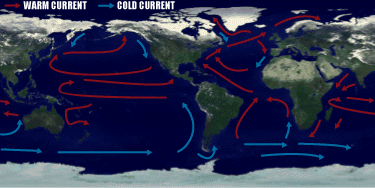Welcome to Shadow Wars Prophecy & Conspiracy Site.We Travel around the United States in our Antique Winnebago monitoring the airwaves and the internet, to bring you what we believe to be the truth. The powers behind the scene, better known as the Shadow Government. |
|
These Atricles where found on the web. We did not Author them, we just reposted them for your information! The Sunday Times - Britain
May 08, 2005 Britain faces big chill
as ocean current slowsJONATHAN LEAKE, SCIENCE EDITOR
CLIMATE change researchers have detected the first signs of a slowdown in the Gulf Stream — the mighty ocean current that keeps Britain and Europe from freezing. They have found that one of the “engines” driving the Gulf Stream — the sinking of supercooled water in the Greenland Sea — has weakened to less than a quarter of its former strength. The weakening, apparently caused by global warming, could herald big changes in the current over the next few years or decades. Paradoxically, it could lead to Britain and northwestern and Europe undergoing a sharp drop in temperatures. Such a change has long been predicted by scientists but the new research is among the first to show clear experimental evidence of the phenomenon. Peter Wadhams, professor of ocean physics at Cambridge University, hitched rides under the Arctic ice cap in Royal Navy submarines and used ships to take measurements across the Greenland Sea. “Until recently we would find giant ‘chimneys’ in the sea where columns of cold, dense water were sinking from the surface to the seabed 3,000 metres below, but now they have almost disappeared,” he said. “As the water sank it was replaced by warm water flowing in from the south, which kept the circulation going. If that mechanism is slowing, it will mean less heat reaching Europe.” Such a change could have a severe impact on Britain, which lies on the same latitude as Siberia and ought to be much colder. The Gulf Stream transports 27,000 times more heat to British shores than all the nation’s power supplies could provide, warming Britain by 5-8C. Wadhams and his colleagues believe, however, that just such changes could be well under way. They predict that the slowing of the Gulf Stream is likely to be accompanied by other effects, such as the complete summer melting of the Arctic ice cap by as early as 2020 and almost certainly by 2080. This would spell disaster for Arctic wildlife such as the polar bear, which could face extinction. Wadhams’s submarine journeys took him under the North Polar ice cap, using sonar to survey the ice from underneath. He has measured how the ice has become 46% thinner over the past 20 years. The results from these surveys prompted him to focus on a feature called the Odden ice shelf, which should grow out into the Greenland Sea every winter and recede in summer. The growth of this shelf should trigger the annual formation of the sinking water columns. As sea water freezes to form the shelf, the ice crystals expel their salt into the surrounding water, making it heavier than the water below. However, the Odden ice shelf has stopped forming. It last appeared in full in 1997. “In the past we could see nine to 12 giant columns forming under the shelf each year. In our latest cruise, we found only two and they were so weak that the sinking water could not reach the seabed,” said Wadhams, who disclosed the findings at a meeting of the European Geosciences Union in Vienna. The exact effect of such changes is hard to predict because currents and weather systems take years to respond and because there are two other areas around the north Atlantic where water sinks, helping to maintain circulation. Less is known about how climate change is affecting these. However, Wadhams suggests the effect could be dramatic. “One of the frightening things in the film The Day After Tomorrow showed how the circulation in the Atlantic Ocean is upset because the sinking of cold water in the north Atlantic suddenly stops,” he said. “The sinking is stopping, albeit much more slowly than in the film — over years rather than a few days. If it continues, the effect will be to cool the climate of northern Europe.” One possibility is that Europe will freeze; another is that the slowing of the Gulf Stream may keep Europe cool as global warming heats the rest of the world — but with more extremes of weather. Gretchen Cook-AndersonHeadquarters, Washington(Phone:
202/358-0836)Alan BuisJet Propulsion Laboratory, Pasadena, Calif.(Phone:
818/354-0474) Dec. 2, 2004
A NASA study suggests changing winds and currents in the Indian Ocean during the 1990s contributed to the observed warming of the ocean during that period. The findings, published in a recent issue of Geophysical Research Letters, have potential implications for long-term regional climate variability. "Establishing this correlation provides an important missing piece to the global ocean-warming puzzle and provides vital information for regional governments and climate modelers," said Dr. Tong Lee, study author and researcher at NASA's Jet Propulsion Laboratory (JPL), Pasadena, Calif. "These findings from satellite data also advance space exploration by increasing understanding of how complex planetary system elements, such as winds and currents, in our home planet interact to drive climate change. Such technologies, which have been demonstrated to be critical in understanding Earth's climate system, may someday prove useful in studying climate systems on other planets," he said. Lee's findings are based on sea level measurements from NASA's Topex/Poseidon oceanographic satellite, sea-surface temperature data from the National Oceanic and Atmospheric Administration's Advanced Very High Resolution Radiometer satellite, and wind data from the European Space Agency's European Remote Sensing satellites. Collected between 1992 and 2000, the combined data reveal weakening of southeasterly trade winds over the South Indian Ocean caused a major circulation of this ocean to wane by nearly 70 percent of its average strength. The atmosphere heats the upper Indian Ocean. The circulation of this ocean counteracts the atmospheric heating by exporting warm surface water and importing colder subsurface water. The slowdown of this circulation tends to prevent warm surface water from exiting and colder subsurface water from entering the upper Indian Ocean, raising its average temperature. During this period, the average sea-surface temperature of the Indian Ocean increased by approximately 0.25 C (0.45 F). "This is a very important and intriguing element of climate observations, suggesting convincingly that a major piece of the world ocean has significantly changed its circulation during the last decade," said Professor Jochem Marotzke, director of the Max Planck Institute for Meteorology in Germany. "While it is too early to say whether the underlying cause is natural variability or human-induced global warming, this result poses an interesting challenge to global climate modelers all over the world," he added. Multi-decadal warming of the Indian Ocean in the past has affected the North Atlantic climate and was blamed for a devastating drought along the southern edge of the Sahara Desert in the 1970s and '80s. Understanding the cause of this warming and predicting its future evolution are major challenges to the climate community, as the ocean's warming is tied into a much larger global cycle of events. This research suggests the Indian Ocean is subject to the same type of long-term ocean-circulation oscillations that drive weather and climate patterns in the Pacific and Atlantic Oceans. "The waning wind and ocean currents of the Indian Ocean might be a manifestation of decadal and longer climate variability. This could have significant effects on the ocean's ability to absorb atmospheric carbon dioxide and the region's marine food web," Lee said. Like vegetation, the ocean is a natural carbon dioxide "sink" that absorbs variable amounts of carbon dioxide from the atmosphere, depending on winds, ocean currents and temperatures. The weakened wind and ocean currents, along with rising ocean temperatures, could hamper the Indian Ocean's ability to absorb carbon dioxide. Ocean phytoplankton, the base of the marine food web, relies on the nourishment brought up by cooler, nutrient-rich subsurface water to survive and reproduce. The slowed cycling of warm and cold water could also bring fewer nutrients from the depths of the ocean to the surface, resulting in a decrease in the region's biological productivity. To review the full text of Lee's study on the
Internet, visit:
- end - The Great Ocean Conveyer Belt
At this site visitors may research average temperatures around the world . The world's oceans travel in well-defined circular
patterns called currents which flow like rivers. When the atmosphere pushes
over the surface of the ocean some of the energy goes to forming waves
while the rest goes to pushing the water in the direction of the wind.
North of the equator currents bend to the right, south of the equator they
bend to the left. This is called the Coriolis effect. Winds, continents
and the Coriolis effect make currents flow around the oceans in huge loops
called gyres.
|




